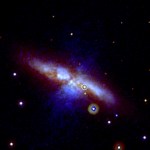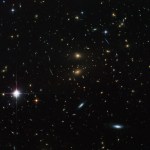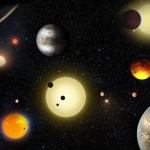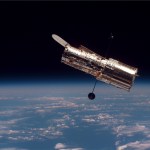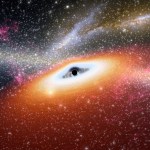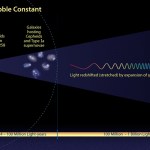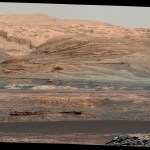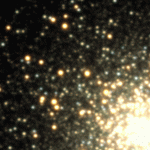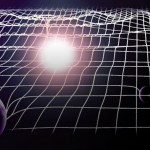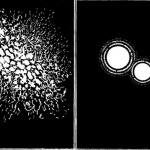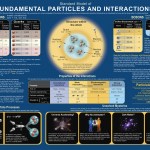
“The beauty of a living thing is not the atoms that go into it, but the way those atoms are put together.” -Carl Sagan
Inside a typical human body, beneath the organs, cells and even molecules that define us, there are atoms: some 7 × 10^27 of them in each of us. Mostly oxygen, carbon, hydrogen and nitrogen (with less than 1% of everything else combined), this tremendous number leads to an intriguing possibility: that at any given moment in your life, some of those atoms were once inside any historical living being you choose.
The elements in the human body. Image credit:…
"It's everywhere, really. It's between the galaxies. It is in this room. We believe that everywhere that you have space, empty space, that you cannot avoid having some of this dark energy." -Adam Riess
Back in the 1990s, scientists were quite surprised to find that when they measured the brightness and redshifts of distant supernovae, they appeared fainter than one would expect, leading us to conclude that the Universe was expanding at an accelerating rate to push them farther away. But a 2015 study put forth a possibility that many scientists dreaded: that perhaps these distant supernovae…
“Even if I stumble on to the absolute truth of any aspect of the universe, I will not realise my luck and instead will spend my life trying to find flaws in this understanding – such is the role of a scientist.” -Brian Schmidt
Imagine you had arbitrarily great technology, limitless energy, and the ability to accelerate as close to the speed of light for as long as you wanted. Would you be able to reach the most distant galaxies, the leftover glow from the Big Bang or anything beyond the limit of what we can see today?
Image credit: NASA, ESA, and Z. Levay (STScI). The GOODS-North survey,…
“There’s no god, it’s the elements that control this world and everything on it.” -Scott A. Butler
From hydrogen through uranium and even beyond, the Universe gives us a huge variety of elements that can bond together in practically innumerable ways, creating all the matter we've ever observed in existence. Everything beyond helium in the periodic table way made inside of stars, but not all stars create elements equally.
Artist’s impression of the red hypergiant VY Canis Majoris. Our Sun will become a more modest red giant, but a giant nonetheless. Image credit: Wikimedia Commons user…
"The diversity of the phenomena of nature is so vast and the treasures hidden in the heavens so rich precisely in order that the human mind shall never be lacking in fresh nourishment." -Johannes Kepler, and the adopted saying of the Kepler mission
The latest haul from NASA's Kepler mission indicates that, in it sample of some 150,000 stars, there are over 2,000 confirmed exoplanets, with approximately 40% of them rocky worlds. If we extrapolate this to our entire galaxy, we have about 60 billion habitable zone planets in our galaxy alone.
The 21 Kepler planets discovered in the habitable…
"In other words, theory attempts to segregate the minimum number of possible worlds which must include the actual world we inhabit. Then the observer, with new factual information, attempts to reduce the list further. And so it goes, observation and theory advancing together toward the common goal of science, knowledge of the structure and observation of the universe." -Edwin Hubble
To gaze into the empty abyss of deep space with the most expensive telescope of all requires a great leap of faith: that you’ll find something worth observing when you look. In 1995, the Hubble Space Telescope…
"Thinking isn't agreeing or disagreeing. That's voting." -Robert Frost
Our first week of may has gone by here at Starts With A Bang, and we're just $26 in pledges short, over on Patreon, of unlocking our next goal! In addition, we've also guest-starred on a Podcast/radio show over at Science For The People, on stories from Beyond The Galaxy:
We’ve also hit on the following articles this week, just in case you missed anything:
Can we use quantum entanglement to communicate faster-than-light? (for Ask Ethan),
Curiosity's first visit to the Martian dunes, in visuals (for…
“A single day is enough to make us a little larger or, another time, a little smaller.” -Paul Klee
When it comes to normal matter, dark matter is a bit of a puzzle. Other than through the gravitational force, there's no way we've yet figured out to make it interact. Try and collide it with matter and it passes right through; try and bombard it with energetic particles or radiation and it's completely transparent. But the story is quite different when it comes to dark matter and black holes.
A black hole feeding off of an accretion disk. Image credit: Mark Garlick (University of Warwick).…
“Even when Darwin’s teaching first made its appearance, it became clear at once that its scientific, materialist core, its teaching concerning the evolution of living nature, was antagonistic to the idealism that reigned in biology.” -Trofim Lysenko
When it comes to many issues, democracy and popular opinion does and should determine the outcome. But when it comes to science and scientific issues, popular opinion or the votes of even an elite group of people doesn't mean very much at all. Instead, it's the truth that the Universe tells us about itself, through experiment, measurement and…
"Gamow was fantastic in his ideas. He was right, he was wrong. More often wrong than right. Always interesting; … and when his idea was not wrong it was not only right, it was new." -Edward Teller
There are few scientific idea more revered or more important than the Big Bang. For the vast majority of human history, we had nothing but wonder, stories, ideas and myths about where our Universe came from and how it got to be the way it is today. Thanks to the Big Bang -- and in particular, to the tremendous scientific achievements of the 20th century -- we now have bonafide scientific answers.…
“Exploration is in our nature. We began as wanderers, and we are wanderers still. We have lingered long enough on the shores of the cosmic ocean. We are ready at last to set sail for the stars.” -Carl Sagan
Glittering above high overhead, the canopy of night offers thousands of points of light, each one a blazing Sun, starring in the story of its own Solar System. But even armed with that knowledge, it's difficult to calculate exactly how far away such a star would actually be. The brightness/distance relationship is a great start, but stars intrinsically come in different brightnesses,…
"I am become death, the destroyer of worlds." -J. Robert Oppenheimer
The nucleus of the atom holds many secrets, not the least of which is the key to the release of energy hundreds of thousands-to-millions of times more efficient than any chemical means known. In order to build and develop the first atomic bomb, a myriad of challenges needed to be overcome, including the ability to sustain a chain reaction among fissile materials.
The Uranium-235 chain reaction that leads to a nuclear fission bomb. Image credit: E. Siegel, based on the original public domain work by Wikimedia Commons user…
"Actually I think Art lies in both directions - the broad strokes, big picture but on the other hand the minute examination of the apparently mundane. Seeing the whole world in a grain of sand, that kind of thing." -Peter Hammill
When fine-and-coarse-grained sand is carried by the winds across uneven terrain, sand dunes form here on Earth. But on Mars, where the atmosphere is only 0.7% what it is here, the sand is made of different composition and the winds gust to up to 60 mph (100 kph), do sand dunes behave the same way?
A close-up of the dunes from the Curiosity rover. Image credit: NASA…
"Science is the only self-correcting human institution, but it also is a process that progresses only by showing itself to be wrong." -Allan Sandage
As April leaves us and May commences here at Starts With A Bang, I'm so pleased to inform you that amazing things are happening! Thanks to the support of everyone on Patreon, we're over 95% of the way towards our next goal: the creation of the most accurate, beautiful, scientific timeline of the Universe's history poster ever made! We've also covered the following topics this past week for you to ring in on:
Could an atmosphere…
"Trying to understand the way nature works involves a most terrible test of human reasoning ability. It involves subtle trickery, beautiful tightropes of logic on which one has to walk in order not to make a mistake in predicting what will happen." -Richard Feynman
If you were to send a space probe to a distant star system, gather information about it and send it back to Earth, you'd have to wait years for the information to arrive. But if you have an entangled quantum system -- say, two photons, one with spin +1 and one with spin -1 -- you could know the spin of the distant one instantly by…
"Nobody grows old merely by living a number of years. We grow old by deserting our ideals. Years may wrinkle the skin, but to give up enthusiasm wrinkles the soul." -Samuel Ullman
When it comes to the Universe, there are some dead giveaways as to what its age is. Its elemental composition changes, the types of stars that are present evolve, the large-scale structure visible to us morphs, grows and ceases, and the temperature of the cosmic microwave background drops, among many other signs.
Image credit: Suzuki et al. (The Supernova Cosmology Project), accepted for publication, Ap.J., 2011.,…
"The fact that gravitational damping is measured at all is a strong indication that the propagation speed of gravity is not infinite. If the calculational framework of general relativity is accepted, the damping can be used to calculate the speed, and the actual measurement confirms that the speed of gravity is equal to the speed of light to within 1%." -Steve Carlip
According to General Relativity, the speed of gravity must be equal to the speed of light. Since gravitational radiation is massless, it therefore must propagate at c, or the speed of light in a vacuum. But given that…
"This event marks the culmination of many years of hard work on behalf of all involved." -Jane Bachynski
If you want to take an ideal image of the Universe, you need to not only minimize your light pollution, cloud cover and build the largest-aperture telescope you can, you also need to take away as much of the atmospheric distortion as you can.
The effects of the Earth’s Atmosphere on the Telescopic Image of alpha Piscium from Edinburgh and from Alta Vista 10,700 ft., compared. From a 1863 engraving by Charles Piazzi Smyth, in the public domain.
Typically, this involved building your…
"The world is the great gymnasium where we come to make ourselves strong." -Swami Vivekananda
But what does it truly mean to be strong? We have four fundamental forces in the Universe: the strong, electromagnetic, weak and gravitational forces. You might think that, by virtue of its name, the strong force is the strongest one. And you'd be right, from a particular point of view: at the smallest distance scales, 10^-16 meters and below, no other force can overpower it.
Image credit: Sloan Digital Sky Survey, of IC 1101, the largest known individual galaxy in the Universe.
But under the…
"The phenomena of nature, especially those that fall under the inspection of the astronomer, are to be viewed, not only with the usual attention to facts as they occur, but with the eye of reason and experience." -William Herschel
We typically think of Saturn as our Solar System’s ringed world, thanks to its huge, glorious rings spanning nearly three times the diameter of the planet from tip-to-tip. But the other three gas giant worlds have their own impressive ring systems, with Jupiter, Uranus and Neptune boasting four, thirteen and five rings, respectively.
A stitching together of two 591…

